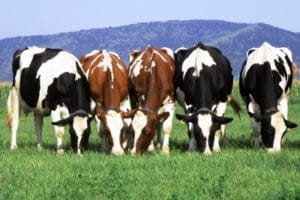Family traditions eased transition to organic practices; pasture saves costs
Capital Press
By STEVE BROWN
CURTIS, Wash. — Dairying organically means more than higher milk prices for farmer Maynard Mallonee. He loves the benefits of pasturing.
“Cows on pasture are healthy cows. They last a lot longer,” he said, adding that one of his cows is in its eighth lactation.

His grandfather, who started the farm in 1950, used no synthetic fertilizers or sprays, believing that the health of the animals originated in the health of the land. The land hasn’t been plowed in 20 years.
Three generations of Mallonees now live on the farm in the Boistfort Valley. Maynard Mallonee works alongside his parents, John and Mary, his wife, Kim, and his three children.
The land was certified organic by Oregon Tilth in 2000. The animals were certified in 2004. Transition to organic was not difficult, Mary Mallonee said. “We always farmed that way.”
Like all organic operations, the farm is labor-intensive, Maynard Mallonee said. “We pull out the weeds instead of spraying.”
“We always carry a hoe,” his mother added.
John Mallonee takes pride in his rich pasture, grazing his Holsteins 220 days of the year and providing 75 percent of their dry matter intake from pasture. The minimums for organic certification are 120 days and 30 percent.
“We use strip grazing, and we move fences every day,” he said. “Giving them new grass every day keeps the milk flow steady.”
He also coordinates pasture rotations to make shade available to the cows in hot weather.
The biggest challenge has been the cost of feed and fuel, he said. To adjust for the recession, he has cut back the cows’ grain. With grazing and silage, the farm produces 95 percent of its feed.
“We pasture April through November,” Maynard Mallonee said. “As we stretch that out, it’s more profitable.”
Price and demand for organic milk have been strong, he said. “We actually got a pay raise in March.”
Producers are paid by weight and quality, which can bring an additional $2.25 per hundredweight, he said. Their federal order blend price is $25.55.
Another selling point is freshness, Mary Mallonee said. “Our milk is in stores within 48 hours.”
When a pair of endangered species were found in the farm’s pastures, a cooperative effort between conservationists and the farm averted possible restrictions on the land.
The farm is the northernmost range of Kincaid’s lupine, a wildflower that serves as a nursery and food source for the Fender’s blue butterfly. The Mallonees protect the existence of both by grazing cows in their habitat.
“Kincaid’s lupine actually does better with a certain amount of grazing,” Joe Arnett, rare plant botanist with the Washington Natural Heritage Program, said. “Cattle are ‘associates’ in preservation.”
The same approach that allows the cattle to thrive has made the pastures an ideal home for the lupine, John Mallonee said. The quality of the soil and the minimal disruption to their pastures are pieces of that puzzle.
Not to mention, “the cows won’t eat it,” Maynard Mallonee said.
Mallonee Farms
Location: Curtis, Wash.
Names: John Mallonee and wife, Mary; son Maynard and wife, Kim, and their three children
Years farming: Family has owned the farm since 1950
Cooperative: Organic Valley and Darigold
Total number of cows: 60
Number of employees: Four family members

